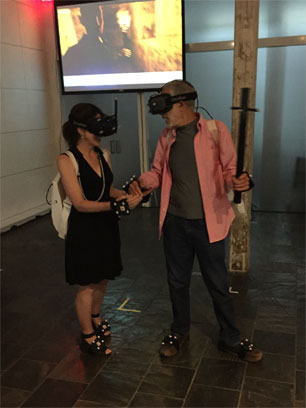Last night's exhibit, "Inside Real Virtuality" by Artanim at Swissnex SF, in which viewers were randomly selected to enter an underground environment of an Egyptian pharaoh's tomb, was not quite a true exercise in virtual heritage. For that, one might hearken back to the work of Fabrizio Funto at Infobyte S.p.A. in the mid-1990s. Funto's team endeavored to accurately replicate places of cultural significance that were in danger of being lost (recall his reconstruction Basilica of San Francesco d'Assisi, destroyed by an earthquake in 1997) and present the results in a virtual reality context. What Artanim adds to the mix in 2015 is the ability for explorers to now bring heir bodies along into such an archeological space.

Artanim's core interest is in motion capture, the ability to digitize movement of the human body in real time. Indeed, co-founder Caecilia Charbonnier is a former tennis pro and their system, 3D in Motion (3DIM) was originally used for motion analytics in sports training and medicine. Such technology is typically used to provide animated characters with life-like actions, but here It is used in conjunction with a head-mounted display to provide a fully immersive virtual experience. So with six discreet body trackers (head, torso, 2 hands, 2 feet), 3DIM is able to transport your body, in the form of an articulated avatar, into the Egyptian scene.
Far from culturally accurate, the scene was more reminiscent of a Tomb Raider video game, with narrow passageways, boiling lava pits, steel spikes, and dusty old skeletons hanging about. But the psychological reaction of the audience participants to this immersive world was the most interesting aspect of the evening. Entering the world two at a time, participants would interact with each other and their underground environment quite naturally, even to the point of trusting the virtual world in front of their eyes more than the physical world under their feet.
Walking down a narrow corridor of the tomb and suddenly faced by an open pit, one gentleman froze in his tracks, unable to move forward until his partner en scene came back to grab his hand and coax him carefully along the perceived ledge and past the threatening obstacle. Another person lost her balance and fell over with a loud thud and gasps from the audience. Fortunately, she was unhurt and after shaking it off she re-donned her helmet and got right back in the world. I spoke with her afterwards to ask what happened. She told me it seemed so real that when she came upon a narrow ledge, she felt the need for physical support to maintain her balance. So, quite naturally, she leaned into the stone wall beside her (which of course existed only in the virtual world).
While Funto's work was truly beautiful and attempted to be historically accurate, what it lacked (as most worlds did in those early days) was any sort of visible human presence, rendering the heritage sites as something of a ghost town. Artanim, perhaps less concerned with the deeper cultural issues, conversely brings that missing life into these formerly vacant environments. What will be even more amazing is when these tools make their way into the hands of archeologists and educators, allowing budding scientists the opportunity to explore reconstructions of distant historic locations as a form of study or possibly even as a means to learn their trade. We'll keep digging into that story.

